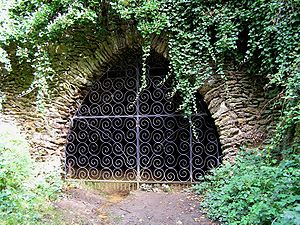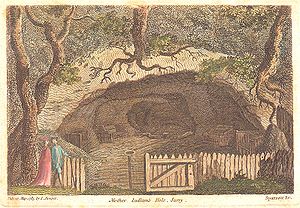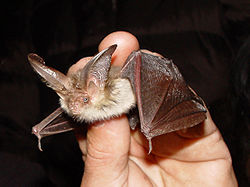
Mother Ludlam's Cave
Encyclopedia

River Wey
The River Wey in Surrey, Hampshire and West Sussex is a tributary of the River Thames with two separate branches which join at Tilford. The source of the north branch is at Alton, Hampshire and of the south branch at both Blackdown south of Haslemere, and also close to Gibbet Hill, near Hindhead...
at Moor Park
Moor Park, Farnham
Moor Park, Farnham, Surrey, England is a Grade II listed house set in some of grounds. It was formerly known as Compton Hall. The present house dates from 1630 but has been substantially altered, particularly in 1750 and 1800...
, near Farnham
Farnham
Farnham is a town in Surrey, England, within the Borough of Waverley. The town is situated some 42 miles southwest of London in the extreme west of Surrey, adjacent to the border with Hampshire...
, Surrey
Surrey
Surrey is a county in the South East of England and is one of the Home Counties. The county borders Greater London, Kent, East Sussex, West Sussex, Hampshire and Berkshire. The historic county town is Guildford. Surrey County Council sits at Kingston upon Thames, although this has been part of...
, England
England
England is a country that is part of the United Kingdom. It shares land borders with Scotland to the north and Wales to the west; the Irish Sea is to the north west, the Celtic Sea to the south west, with the North Sea to the east and the English Channel to the south separating it from continental...
, the subject of local legend
Legend
A legend is a narrative of human actions that are perceived both by teller and listeners to take place within human history and to possess certain qualities that give the tale verisimilitude...
s. A spring
Spring (hydrosphere)
A spring—also known as a rising or resurgence—is a component of the hydrosphere. Specifically, it is any natural situation where water flows to the surface of the earth from underground...
rising in the cave is recorded in the 13th century "Annals of Waverley Abbey" as "Ludewell"; other spellings through history include "Ludwell" and "Luddwelle". A monk named Symon is credited with identifying the spring as a suitable water supply for Waverley Abbey
Waverley Abbey
Waverley Abbey was the first Cistercian abbey in England, founded in 1128 by William Giffard, Bishop of Winchester. It is situated about one mile south of Farnham, Surrey, in a bend of the River Wey.-History:...
in 1218, after the original source had dried up. The brothers of the abbey dedicated the spring to St Mary, so it also became known as St Mary's Well. The cave has been naturally formed by the spring but may have been enlarged by the monks and was made into a grotto
Grotto
A grotto is any type of natural or artificial cave that is associated with modern, historic or prehistoric use by humans. When it is not an artificial garden feature, a grotto is often a small cave near water and often flooded or liable to flood at high tide...
(possibly during the eighteenth century) and further enhanced by addition of an ironstone
Ironstone
Ironstone is a sedimentary rock, either deposited directly as a ferruginous sediment or created by chemical repacement, that contains a substantial proportion of an iron compound from which iron either can be or once was smelted commercially. This term is customarily restricted to hard coarsely...
arched entrance, possibly during the reign of Queen Victoria.
Origins of the name
According to the information panel erected at the cave by Waverley Borough CouncilWaverley, Surrey
Waverley is a local government district with borough status in Surrey, England. The borough's headquarters are in the town of Godalming, with Farnham and Haslemere being the other large notable towns....
the name Ludwell can be traced back to the Celtic language
Celtic languages
The Celtic languages are descended from Proto-Celtic, or "Common Celtic"; a branch of the greater Indo-European language family...
, and means "bubbling spring". John Aubrey
John Aubrey
John Aubrey FRS, was an English antiquary, natural philosopher and writer. He is perhaps best known as the author of the collection of short biographical pieces usually referred to as Brief Lives...
visited the area in 1673 and was informed that Ludwell was named after Lud, King of the South Saxons, who went there to bathe his wounds after a battle. In a tradition originating with the Norman-Welsh writer of historicised legend Geoffrey of Monmouth
Geoffrey of Monmouth
Geoffrey of Monmouth was a cleric and one of the major figures in the development of British historiography and the popularity of tales of King Arthur...
, Ludd
Lud son of Heli
Lud , according to Geoffrey of Monmouth's legendary History of the Kings of Britain and related medieval texts, was a king of Britain in pre-Roman times. He was the eldest son of Geoffrey's King Heli, and succeeded his father to the throne. He was succeeded, in turn, by his brother Cassibelanus...
(or Llud) was the ruler of Celtic Britain and founder of London. A modern ethnographer would identify Lud as a Celtic god: a temple dedicated to him once stood in London near Ludgate
Ludgate
Ludgate was the westernmost gate in London Wall. The name survives in Ludgate Hill, an eastward continuation of Fleet Street, and Ludgate Circus.-Etymology:...
, which is named after him, as are numerous toponyms in England and a very few in Ireland. He is also known as the Celtic god of healing which may indicate that the spring which rises in the cave was a holy well or sacred spring long before the monks of nearby Waverley Abbey
Waverley Abbey
Waverley Abbey was the first Cistercian abbey in England, founded in 1128 by William Giffard, Bishop of Winchester. It is situated about one mile south of Farnham, Surrey, in a bend of the River Wey.-History:...
used it as a source of fresh water and rededicated it to St Mary. The antiquarian
Antiquarian
An antiquarian or antiquary is an aficionado or student of antiquities or things of the past. More specifically, the term is used for those who study history with particular attention to ancient objects of art or science, archaeological and historic sites, or historic archives and manuscripts...
The "Lud" element of the name is maintained in the more recent connection with "Mother Ludlam".
The legend of Mother Ludlam, the White Witch of Waverley
The cave has long been associated with the legendLegend
A legend is a narrative of human actions that are perceived both by teller and listeners to take place within human history and to possess certain qualities that give the tale verisimilitude...
of "Mother Ludlam" who was, supposedly, a white witch
White witch
White witch and good witch are qualifying terms in English used to distinguish practitioners of folk magic for benevolent purposes from practitioners of malevolent witchcraft...
who lived in the cave. The earliest versions of the legend, such as that recorded by John Aubrey
John Aubrey
John Aubrey FRS, was an English antiquary, natural philosopher and writer. He is perhaps best known as the author of the collection of short biographical pieces usually referred to as Brief Lives...
in 1673 in his Natural History and Antiquities of Surrey, make no mention of a witch and it is likely that the story was originally associated with fairies.
Various versions of the legend have existed. The simplest version is that Mother Ludlam would loan utensils and that a large cauldron was borrowed but not returned; she became enraged and the borrower, scared by her anger, sought refuge in Frensham
Frensham
Frensham is a village in Surrey, England, beside the A287, south west of Guildford. Neighbouring villages include Millbridge, Shortfield Common, Dockenfield, Spreakley, Batt's Corner and Rushmoor. Frensham lies on the River Wey. Farnham is the nearest main town and it is to the north. The...
Church. The cauldron associated with this legend remains in the church to this day, but is believed by historians to have been used for brewing church ale in past times - made of hammered copper and measuring three feet in diameter and 19 inches deep, it is of the type that was commonly used in the Middle Ages for catering at parishioners' weddings and religious festivals.
As recorded in 1937 the legend is that one day the Devil
Devil
The Devil is believed in many religions and cultures to be a powerful, supernatural entity that is the personification of evil and the enemy of God and humankind. The nature of the role varies greatly...
, in disguise, had visited Mother Ludlam and asked to borrow the cauldron she used for mixing her potions. Recognising the Devil from his hoof-prints in the sand, she refused, so the Devil stole the cauldron, with the witch in pursuit. Making great leaps, the Devil created a series of hills where he touched the ground, these now being the sandstone hills near Churt
Churt
Churt is a village and civil parish in the borough of Waverley in Surrey, England. It is located on the A287 road between Hindhead and Farnham, and is split by the Surrey–Hampshire borders. Its origins date back to the Saxon period. The original boundary stones are visible at the junction of Green...
, known as the Devil's Jumps
Devil's Jumps, Churt
The Devil's Jumps are a series of three small hills near the village of Churt in the county of Surrey in southern England. In the 18th century the hills were known as the Devil's Three Jumps. The Devil's Jumps are linked to a body of folklore relating to the surrounding area. The highest of the...
. The Devil dropped the cauldron - or kettle - on the last of these hills, "Kettle Bury", or "Kettlebury Hill". Mother Ludlam recovered the cauldron and placed it in Frensham Church, where it would be safe from the Devil.
Another version, recorded in the 1920s, is that the cauldron could be borrowed by climbing the highest of the Devil's Jumps (known as Stony Jump), and whispering to the fairies who lived there through a hole in the rocky outcrop on the summit. A borrower failed to return it on time, so the fairies condemned the borrower to have the cauldron follow him wherever he went. Distressed by the presence of his pursuer, he sought sanctuary in Frensham Church where he collapsed and died, leaving the cauldron trapped inside.
William Cobbett

William Cobbett
William Cobbett was an English pamphleteer, farmer and journalist, who was born in Farnham, Surrey. He believed that reforming Parliament and abolishing the rotten boroughs would help to end the poverty of farm labourers, and he attacked the borough-mongers, sinecurists and "tax-eaters" relentlessly...
wrote of the cave in his Rural Rides
Rural Rides
Rural Rides is the book for which the English journalist, agriculturist and political reformer William Cobbett is best known.At the time of writing in the early 1820s, Cobbett was a radical anti-Corn Law campaigner, newly returned to England from a spell of self-imposed political exile in the...
, recounting his visit of 27 October 1825::
"From Waverley we went to Moore ParkMoor Park, FarnhamMoor Park, Farnham, Surrey, England is a Grade II listed house set in some of grounds. It was formerly known as Compton Hall. The present house dates from 1630 but has been substantially altered, particularly in 1750 and 1800...
, once the seat of Sir William Temple, and, when I was a very little boy, the seat of a lady or a Mrs Temple. Here I showed Richard "Mother Ludlum's Hole"; but, alas! it is not the enchanting place that I knew it, nor that which GroseFrancis GroseFrancis Grose was an English antiquary, draughtsman, and lexicographer. He was born at his father's house in Broad Street, St-Peter-le-Poer, London, son of a Swiss immigrant and jeweller, Francis Jacob Grose , and his wife, Anne , daughter of Thomas Bennett of Greenford in Middlesex...
describes in his Antiquities! The semicircular paling is gone; the basins to catch the never-ceasing little stream are gone; the iron cups, fastened by chains, for people to drink out of, are gone; the pavement all broken to pieces; the seats, for people to sit on, on both sides of the cave, torn up, and gone; the stream that ran down a clean paved channel, now making a dirty gutter; and the ground opposite, which was a grove, chiefly of laurels, intersected by closely-mowed grass walks, now become a poor ragged-looking alder-coppice."
Sadly the cave is now in an even more dire state of repair following collapse of part of its roof during the drought
Drought
A drought is an extended period of months or years when a region notes a deficiency in its water supply. Generally, this occurs when a region receives consistently below average precipitation. It can have a substantial impact on the ecosystem and agriculture of the affected region...
of 1976, which also affected the floor of the cave by covering the remaining signs of habitation with a large mound of sand. The cave would be a very suitable subject for restoration in a manner sympathetic to its bat roost.
Wildlife

Natterer's bat
Natterer's bat is a European bat with pale wings. It has brown fur, also seen on the leg wing membrane, tending to white on its underside...
(Myotis nattereri), Daubenton's Bat
Daubenton's bat
Daubenton's Bat, Myotis daubentonii, is a Eurasian bat with quite short ears. It ranges from Britain to Japan and is considered to be increasing its numbers in many areas.The name commemorates the French naturalist Louis-Jean-Marie Daubenton....
(M. daubentonii) and Long-eared Bat
Brown long-eared bat
The brown long-eared bat or common long-eared bat is a fairly large European bat. It has distinctive ears, long and with a distinctive fold...
(Plecotus auritus) exist in some numbers. Conservation efforts are now encouraging a return of the Greater Horseshoe Bat
Greater Horseshoe Bat
The Greater Horseshoe Bat is a European bat of the Rhinolophus genus. Its distribution covers Europe, Africa, South Asia and Australia. It is the largest of the European Horseshoe Bats and is thus easily distinguished from other species...
(Rhinolophus ferrumequinum). The entrance to the cave has been the subject of a partnership project between Waverley Borough
Waverley, Surrey
Waverley is a local government district with borough status in Surrey, England. The borough's headquarters are in the town of Godalming, with Farnham and Haslemere being the other large notable towns....
, English Nature
English Nature
English Nature was the United Kingdom government agency that promoted the conservation of wildlife, geology and wild places throughout England between 1990 and 2006...
, and Farnham Town Council in 2001/2002, to provide a replacement for an earlier, damaged, ornamental grille to protect the cave and the bat roost. English Nature has a design for a low cost bat grille for the hole in the cave roof. Opposite the cave entrance is the Moor Park Nature Reserve of the Surrey Wildlife Trust
Surrey Wildlife Trust
Surrey Wildlife Trust is a Wildlife Trust in Surrey, a county in South East England. The Trust's vision is for a living landscape in Surreythat is rich in wildlife and valued by all. It is the only organisation in Surrey that cares for all forms of wildlife in the county.Surrey Wildlife Trust is...
, which is an SSSI consisting mainly of alder carr.
Father Foote's Cave
Above Mother Ludlam's Cave (on private land) is another, smaller, cave known as Father Foote's Cave, which is the subject of another story. A man named Foote allegedly dug the cave and took shelter here, having previously stayed at the Seven Stars inn in Farnham for a while. He was found lying, unwell, one day by the stream. He was taken to Farnham workhouseWorkhouse
In England and Wales a workhouse, colloquially known as a spike, was a place where those unable to support themselves were offered accommodation and employment...
, where he died the same day in 1840. His last words were "Take me to the cave again". How his name became transmuted to Father Foote is not recorded.

